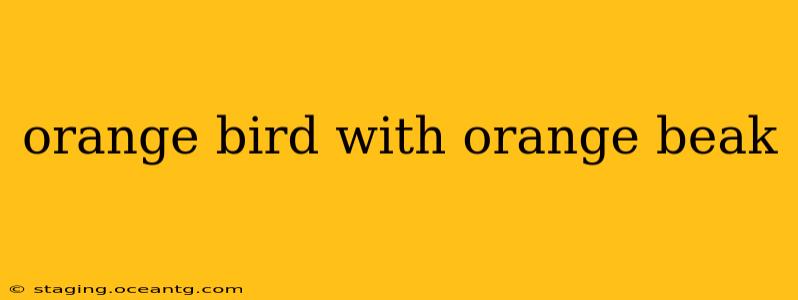Many birds boast vibrant orange plumage, but an orange bird with an orange beak narrows down the possibilities considerably. While pinpointing the exact species requires more information (location, size, habitat, etc.), we can explore some likely candidates and discuss the features that help differentiate them. This guide will help you identify that fiery avian friend you've spotted.
What kind of orange bird has an orange beak?
This is a common question, and the answer depends heavily on the bird's geographic location. There isn't one single definitive answer. Several species exhibit orange plumage and beaks, each with unique characteristics. To accurately identify the bird, consider the following:
- Location: Where did you see the bird? Knowing the continent, country, or even state/province significantly narrows down the possibilities.
- Size: Was the bird small (like a finch), medium (like a robin), or large (like a parrot)?
- Habitat: Where was the bird located? Forest, grassland, wetland, coastal area?
- Behavior: What was the bird doing? Foraging, singing, flying? These observations can provide valuable clues.
Are there any small orange birds with orange beaks?
Yes, several smaller birds exhibit orange hues in their feathers and beaks. However, a completely uniform orange coloration throughout the beak and plumage is less common. Often, the orange might be more concentrated in certain areas like the breast, belly, or head, while other parts might display different shades. It's essential to look at the overall coloration pattern. Examples (depending on location) could include certain species of:
- Sunbirds: Many sunbird species display vibrant orange coloration, although beak color can vary.
- Tanagers: Some tanagers, particularly those found in the Americas, have orange or orange-tinged plumage and beaks.
- Finches: Though less common, some finch species might exhibit shades of orange.
What kind of big orange bird has an orange beak?
Larger birds with orange plumage and beaks are less frequent but still exist. Again, geographical location is vital. Potentially, you might be looking at:
- Certain Parrot Species: Several parrot species exhibit predominantly orange coloration with orange beaks. However, the beak’s shape and size are vital distinguishing features here.
- Some species of Turaco: These African birds are known for their vibrant plumage, which can include shades of orange. The beak color can also vary within the species.
Are there any orange birds with partially orange beaks?
Yes, many birds may have an orange hue on part of their beaks, rather than a completely uniform orange beak. The base of the beak, the tip, or only the upper mandible might be orange while the rest differs. This subtle variation is important for proper identification. Always consider the entire beak color along with the overall bird coloration to get a more precise result.
How can I identify an orange bird with an orange beak more accurately?
To accurately identify an orange bird with an orange beak, use a combination of strategies:
- Field Guide: Consult a regional bird identification guide for your area. These guides contain detailed descriptions, illustrations, and range maps.
- Online Resources: Websites like eBird, Audubon, or the Cornell Lab of Ornithology offer vast databases of bird species and identification tools. Use their search functions with details about the bird's size, location, and behavior.
- Birdwatching Apps: Several mobile apps offer bird identification features using image recognition or descriptive input.
- Photograph: A clear photograph of the bird is invaluable. Upload the image to online bird identification communities or use image recognition features in birdwatching apps for help with identification.
Remember, detailed observation and utilizing various resources are crucial for accurate bird identification. If possible, include a photograph when seeking help from birdwatching experts or online communities!
